Yamadera Temple, one of Japan's most famous temples that was visited by the renowned poet Basho
Yamadera Temple is one of the most sacred mountain temples in the Tohoku region. The temple's official name is Hojusan Risshakuji. It is known as the place where Matsuo Basho, one of Japan's most famous haiku poets, wrote his haiku "Shizukesa ya / iwa ni shimiiru / semi no koe" (Such stillness / the cicadas' cries / sink into the rocks). Here, we will introduce the visit route and highlights of Yamadera Temple.

1. Konpon Chudo, the oldest hall in Japan built of beech wood

Konpon Chudo is the temple hall located right at the entrance point to the path up the mountain. It is said to be the oldest beech wood building in Japan, and is a designated Important Cultural Property. Inside the hall, a flame continues to be lit that was originally parted from the flame at Enryakuji Temple on Mount Hiei when Yamadera Temple was founded. The hall also contains a wooden Buddha statue that is said to have been made by Jikaku Daishi, the founder of Yamadera Temple.
Column
Statues of the poets Basho and Sora and the poetry monument
There are statues of the poets Basho and Sora located on the path between Konpon Chudo hall and the main temple gate. Matsuo Basho, who visited the temple during his journey in which he wrote "The Narrow Road to the Deep North," composed the famous haiku "Shizukasa ya / iwa ni shimiiru / semi no koe" (Such stillness / the cicadas' cries / sink into the rocks). There is also a monument to this haiku between Konpon Chudo hall and the statue of Basho.

2. Sanmon, the main temple gate to the stone stairs leading to the inner sanctuary

The Sanmon gate has a thatched roof built during the Kamakura period (1185-1333). There are more than 800 stone steps leading from the gate to the inner sanctuary. The reception area is open from 8 a.m. to 5 p.m. Pay the entrance fee and set off for a full-scale visit to the temple.
*The entrance fee is 300 yen for adults, 200 yen for junior high school students, and 100 yen for elementary school students and infants.
Column
Build up your strength before tackling the 800-plus stone steps
Yamadera Temple's Tama-konnyaku is known as "Chikara Konnyaku" (power konnyaku) and it is said to give you strength if you eat it before visiting Yamadera Temple. It has a firm texture and the flavor of soy sauce that has soaked into the Chikara Konnyaku fills your mouth. You can eat it at various locations such as the teahouse located between the mountain trail entrance and the mountain gate, so why don't you give it a try?
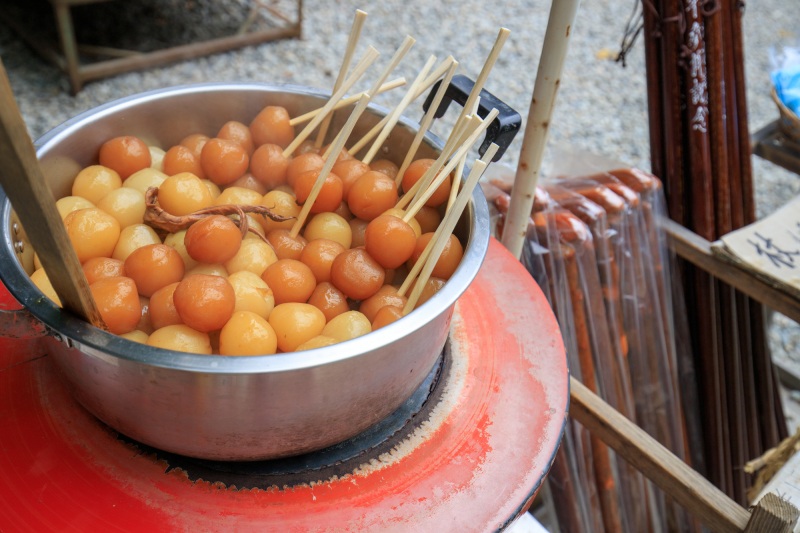
3. The Semizuka mound where Basho's poem is buried
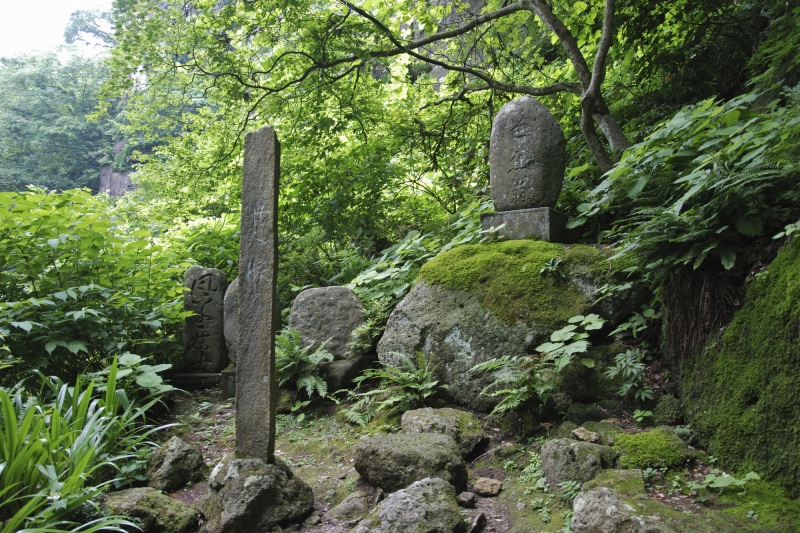
The Semizuka mound is located about 15 minutes up the stone stairs from the temple gate. This is the place where Basho buried the paper strips on which he wrote the haiku "Shizukasa ya / iwa ni shimiiru / semi no koe" (Such stillness / the cicadas' cries / sink into the rocks), and built a monument. In the summer, you can hear the sound of cicadas here and there along the shrine road, just as Basho did.
4. Midahora rocks carved by the wind and rain

Midahora, which is located between Semizuka mound and Niomon gate, is a rocky area carved naturally by rain and wind over many years to create a shape that resembles Amida Nyorai (Amitabha) Buddha standing upright. The figure is about 4.8 meters tall. It is said that those who can see the Buddha's figure will be blessed with good luck.
5. At Niomon Gate, look out for the glares of the two gods known as Nio on the left and right of the gate!
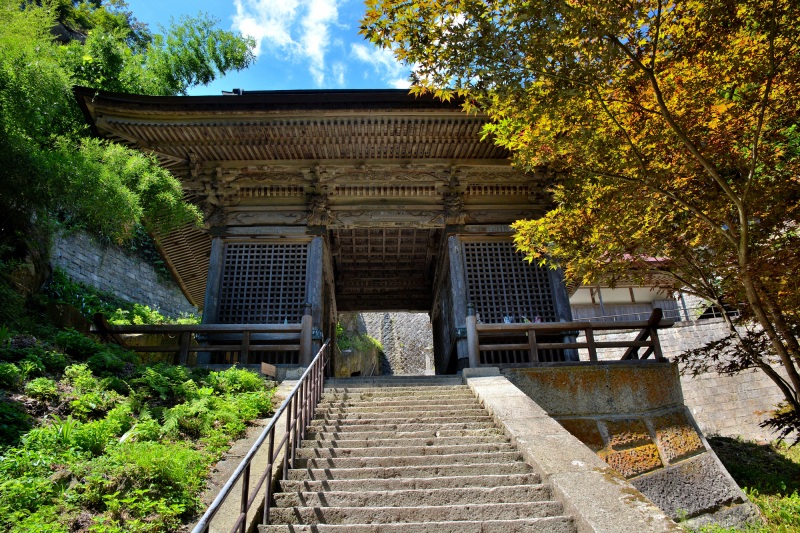
Niomon gate is located about midway along the temple road, about 20 minutes from the Sanmon main temple gate. It is a beautiful gate made of zelkova wood, and the Nio statues on either side of the gate have powerful expressions. They seem to be glaring at you, telling you not to climb up if you have an evil heart.
6. The Okunoin inner sanctuary and Great Buddha hall at the end of the temple road

The Okunoin inner sanctuary is the end of the stone staircase that had more than 800 steps. It enshrines two Buddhist statues that are said to have been carried by Jikaku Daishi as part of his ascetic practice in China. The large lantern by the stone steps is made of gold and is said to be one of the three largest lanterns in Japan. Take note of the detailed handiwork of the dragon and other details. To the left of the Nyohodo Hall is the Daibutsuden (Great Buddha Hall), which enshrines the golden Great Buddha that is five meters tall.
7. Kaizando, a hall dedicated to Jikaku Daishi, the founder of Yamadera Temple
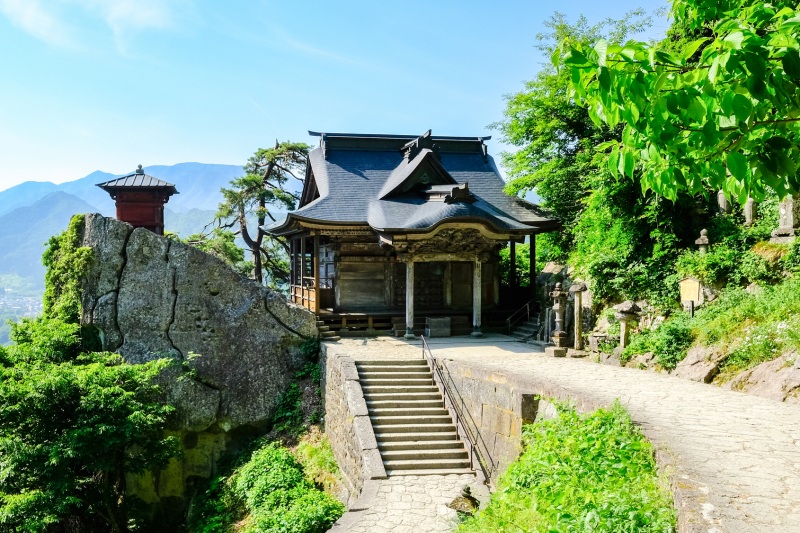
Kaizando Hall contains a statue of Jikaku Daishi, and food and incense are still offered without fail to the statue every morning and evening. The red hall on the rock to the left is Nokyodo where sutras are stored. It is said to be the oldest building of Yamadera Temple.
8. Godaido Hall, the best view spot of Yamadera Temple
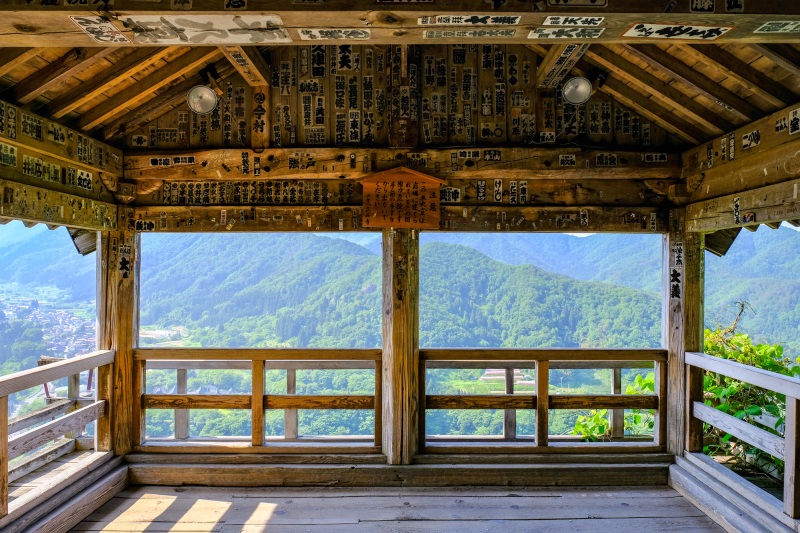
Godaido Hall, a place to pray for peace and tranquility in the world, is the best view spot of Yamadera Temple. The hall juts out from a cliff, and you can see the cliffs where monks once practiced asceticism and the temple town at the foot of the cliff. Why don't you enjoy the spectacular scenery at this energy-filled view spot?
Column
Visiting the Yamadera Basho Museum is recommended for after you go to the temple!
This memorial museum displays haiku written by Matsuo Basho, a haiku poet. The museum also displays a video and materials explaining Basho's journey in "The Narrow Road to the North."

Route and time required to visit Yamadera Temple
The estimated time to visit Yamadera Temple is about 1 hour and 30 minutes for a round trip. There are a total of 1,015 stone steps from the entrance to the mountain path, so it is recommended that you wear sneakers or other non-slip shoes.
[Time required to visit the temple]
Mountain entry point ⇒ (about 3 min.) ⇒ Konpon Chudo ⇒ (about 5 min.) ⇒ Sanmon Gate ⇒ (about 15 min.) ⇒ Semizuka mound ⇒ (about 5 min.) ⇒ Niomon Gate ⇒ (about 15 min.) ⇒ Okunoin, Daibutsuden ⇒ (about 10 min.) ⇒ Kaizando Hall ⇒ (about 1 min.) ⇒ Godaido Hall
There are also times when the temple is lit up

Every year from late July to mid-August and from late October to early November, the "Yamadera Temple Light-up and Road of Light" is held for a limited time. Godaido Hall, Kaizando Hall, Nokyodo Hall, and Shakado Hall are illuminated, and you can see the beautiful halls floating in the darkness of the mountains. In addition, about 200 candles are lit along the road from Yamadera Station to Konpon Chudo Hall, creating a wondrous atmosphere that is completely different from that in the daytime. During the autumn illumination period, the autumn leaves are at their best. Why don't you visit Yamadera Temple at night when the lights make it shine even more?